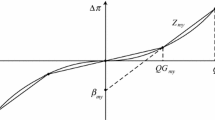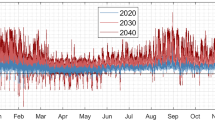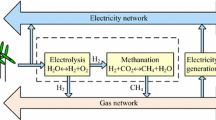Abstract
The integration of natural gas and electricity sectors has increased sharply in the last decade as a consequence of combined cycle natural gas thermal power plants. In some countries such as Brazil, gas-fired generation has been a major factor in the overall growth of natural gas consumption. When related to the operations planning, in some hydrothermal systems, a national system operator dispatches these gas-fired plants (along with other thermal sources such as coal, oil, and nuclear) in conjunction with the country’s hydroelectric plants by using a production-costing model based on stochastic programming. The algorithm determines the optimal hydro-to-thermal energy production ratio on the basis of the expected benefit of reducing thermal plant generation over a large number of hydrological scenarios, along a planning horizon of some years. This means that the optimal scheduling decision today depends on the assumptions about future load growth and future entrance of new generation capacity. Stochastic dynamic programming models are extensively used. However, the hydrothermal scheduling models usually do not take into account the possibility of future fuel supply constraints, either in production or in transportation. The assumption of fuel supply adequacy is felt to be reasonable for the more mature markets such as coal and oil. However, because of the fast growth of the natural gas market, it is possible that demand outpaces supply or transportation investments. Indications that gas-related constraints could be relevant were observed in New England, in the US, and in Brazil in 2004, where several megawatt of combined-cycle generation could not be dispatched when needed due to constraints in pipeline capacity. The objective of this work is to present a methodology for representing the natural gas supply, demand, and transportation network in the stochastic hydrothermal power scheduling model. Application of the integrated electricity–gas scheduling model is illustrated in case studies, with realistic configurations of the 90GW Brazilian system.
Access this chapter
Tax calculation will be finalised at checkout
Purchases are for personal use only
Preview
Unable to display preview. Download preview PDF.
Similar content being viewed by others
References
Barroso LA, Flach B, Kelman R, Bezerra B, Binato S, Bressane JM, Pereira MV (2005) Integrated gas-electricity adequacy planning in Brazil: technical and economical aspects. Proceedings of the IEEE PES general meeting, San Francisco
OECD, International Energy Agency (2003) South American gas – daring to tap the bounty, OECD/IEA, Paris, 253 p
Mercado RR (2002) Natural gas pipeline optimization. Pardalos PM, Resende MGC (eds) Handbook of applied optimization Oxford university Press, New York
Wolf D, Smeers Y (2000) The gas transmission problem solved by an extension of the simplex algorithm. Manage Sci 46(11):1454–1465
Munoz J, Redondo NJ, Ruiz JP (2002) Natural gas network modeling for power systems reliability studies. IEEE PES-Summer Meeting. Chicago
Mello OD, Ohishi T (2004) Natural gas transmission for thermoelectric generation problem. IX Simpósio de Especialistas em Planejamento da Operação e Expansão Elétrica, Maio
Pereira MV, Campodónico N, Kelman R (1998) Long-term hydro scheduling based on stochastic models. Proceedings of EPSOM Conference, Zurich, Available at http://www.psr-inc.com
Granville S, Oliveira GC, Thomé LM, Campodónico N, Latorre ML, Pereira M, Barroso LA (2003) Stochastic optimization of transmission constrained and large scale hydrothermal systems in a competitive framework. Proceedings of the IEEE general meeting, Toronto
Pereira MVF, Pinto LMVG (1984) Operation planning of large-scale hydrothermal systems. Proceedings of the 8th PSCC, Helsinki, Finland
Pereira MVF, Pinto LMVG (1985) Stochastic optimization of multireservoir hydroelectric system – a decomposition approach. Water Resour Res 21(6)
Gorenstin BG, Campodónico NM, Costa JP, Pereira MVF (1992) Stochastic optimization of a hydrothermal system including network constraints. IEEE Transactions on PAS 7(2):791–797
Read E, George J (1990) Dual dynamic programming for linear production/inventory systems. Comput Math Appl 19(11):29–42
Author information
Authors and Affiliations
Corresponding author
Editor information
Editors and Affiliations
Rights and permissions
Copyright information
© 2010 Springer-Verlag Berlin Heidelberg
About this chapter
Cite this chapter
Bezerra, B. et al. (2010). Integrated Electricity–Gas Operations Planning in Long-term Hydroscheduling Based on Stochastic Models. In: Pardalos, P., Rebennack, S., Pereira, M., Iliadis, N. (eds) Handbook of Power Systems I. Energy Systems. Springer, Berlin, Heidelberg. https://doi.org/10.1007/978-3-642-02493-1_7
Download citation
DOI: https://doi.org/10.1007/978-3-642-02493-1_7
Published:
Publisher Name: Springer, Berlin, Heidelberg
Print ISBN: 978-3-642-02492-4
Online ISBN: 978-3-642-02493-1
eBook Packages: EngineeringEngineering (R0)




